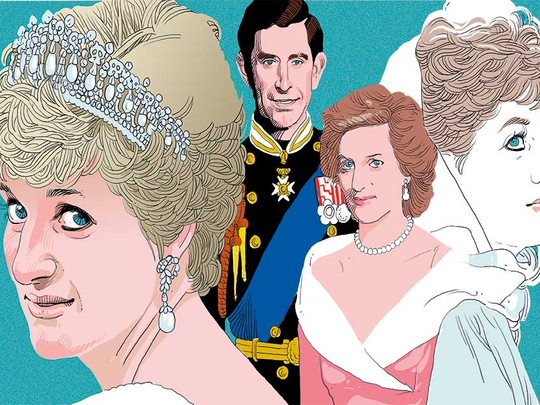
Two decades after the death of Diana, the “People’s Princess” continues to capture the popular imagination of many in the United Kingdom and around the world. In part, this is because of the strength of the legacy of her charitable endeavours, which have been recognised across much of the globe.
Yet, her tragic and untimely passing two decades ago, which led to Queen Elizabeth II facing one of her most turbulent times in office, continues to be problematic for the British royal family. Only last week, for instance, a YouGov poll found that almost a third of the UK public feels the royal family has not shown Diana’s memory enough respect.
And this feature of public opinion is particularly troubling for Charles, Diana’s former husband and heir to the throne, with only a third in the same survey believing “he has been beneficial for the royal family”. This is down by nearly two-thirds compared to four years ago, underlining that a rockier road may lie ahead for the monarchy.
Looking back from the vantage point of today, Diana’s death — and the period during and after her marital troubles with Charles — was one of the toughest periods in the Queen’s reign as the longest-serving monarch in UK history. It is now some six-and-a-half decades ago that she assumed the throne when Winston Churchill was UK prime minister, Joseph Stalin was leader of the Soviet Union, Harry Truman was the US president, and Mao Zedong was the Chinese Communist leader, and she therefore represents a figure of significant continuity for many.
Yet, amidst the high esteem that Elizabeth and some other members of the royal family are currently held, what is sometimes now forgotten is how difficult parts of the 1990s were for her. For instance, 1992 was her self-described “annus horribilis” when the marriages of three of her children — including that of Charles to Diana — disintegrated in the public spotlight, and her beloved Windsor Castle was also nearly destroyed by fire.
Later in the decade too, the Queen’s response to Diana’s death was quite widely disparaged. In the immediate aftermath of her former daughter-in-law’s passing, for instance, Elizabeth was criticised — in some quarters — for failing to return to London quickly enough from her Summer sojourn in Scotland where she was comforting Princes William and Harry. While many sympathised with her wanting to be a caring grandmother, few understood why the Buckingham Palace flagpole was kept bare, as was protocol while she was away, rather than lowering a flag to half mast in respect to Diana.
While that 1997 episode remains a troubled one for the Queen, she acknowledged just ahead of Diana’s funeral that “there are lessons to be drawn from her life and from the extraordinary and moving reaction to her death”. And indeed almost a half of the UK public (44 per cent), according to YouGov, today believes that part of Diana’s legacy is that the royal family has changed for the better.
Approval rating
While the significant changes to the royal family derive from a wide range of factors, Diana would probably have approved of a modernised monarchy for her son William to inherit. Key recent reforms include ending the rule of male primogeniture on the throne, which means girls now born to members of the royal Family have equal rights with boys in the succession to the throne; and ending the prohibition on Elizabeth’s successors marrying a Catholic.
Two decades on, the Queen and immediate family have largely recovered from the troubles of the 1990s, and younger members, including William, have helped power the ruling clan’s popularity ratings in recent years. Aside from the Queen and her husband Prince Philip, the YouGov poll showed that William is regarded as having made the best contribution to the royal family with 78 per cent approval rating, followed by Harry (73 per cent), and William’s wife Kate (73 per cent). Charles, however, and his second wife Camilla trail way behind on 36 per cent and 18 per cent, respectively.
Moreover, polls tend to show that less than a quarter of the UK population want a republic, with many people believing that it is better to have a non-divisive, non-political head of state. This factor may become even more important, in the future, given that the nation appears to potentially becoming increasingly divided on geographic lines, especially given increased pressure for independence in Scotland.
Going forward, a key question is whether or not the Queen, now at 91 years of age, might choose to abdicate before she dies, and also how the monarchy will fare in the post-Elizabeth II period. On the first question, speculation has heightened following the abdications in 2013 of both Queen Beatrix of the Netherlands, and King Albert of Belgium.
The Queen has already stepped back from duties requiring long-distance flights. However, there are no obvious signs yet that she will not follow the example of her great-grandmother Queen Victoria (1837-1901), the previous holder of record longevity for a sitting UK monarch, who died in office.
On the second issue, Charles at 68 is already at an age when many people are retired, and is the longest-waiting and oldest heir to the throne in UK history. Moreover, as the YouGov poll underlines, his personal popularity is not nearly as high as his mother and father, nor that of his sons and daughter-in-law.
Indeed, some surveys show that a significant body of the UK public would prefer the monarchy to skip a generation to William upon the Queen’s passing. This leaves open the possibility that the royal family could become less popular under Charles’s rule, not least given public indifference towards Camilla.
Taken overall, the royal family has largely recovered its public standing from the 1990s, but Diana’s legacy continues to be mixed for it. Significant uncertainties remain about the post-Elizabeth II period, especially given popular sentiments towards Charles, and this means the monarchy could face a rockier road ahead.
Andrew Hammond is an Associate at LSE IDEAS at the London School of Economics.








